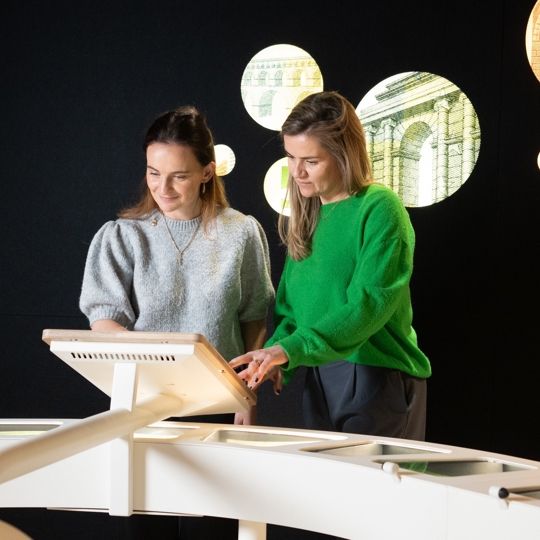Education
Learn all about the economy


The National Numismatic Collection (NNC) recently acquired a very special coin. To mark the occasion, let’s take a look at coin portraiture.
The curly hair, the high cheekbone and the distinctive nose on this bronze coin measuring just half an inch in diameter belong to the Persian provincial governor Tissaphernes (413-395 BCE). Tissaphernes is the first person to have his face depicted on a coin during his lifetime, marking the start of a very important development in the history of coinage.
Coins are, of course, first and foremost a means of payment. But coins are also a great means of communication. Coins last a long time; they are produced in large numbers and many people deal with them on a daily basis. That is why coin-issuing authorities and rulers have always used them to convey messages and project power. Coin portraiture is the ultimate symbol of power and - with Tissaphernes as its pioneer- it was a major innovation in the period around 400 BCE. Portraits and associated symbols, such as a diadem or sceptre, allowed rulers to convey their - sometimes even divine - qualities. Coins don't get any more personal than that!

© De Nationale Numismatische Collectie, De Nederlandsche Bank

Portrait of the deified Alexander the Great on a coin of Ptolemy I, struck in 310-305 BCE
(silver, 27 mm; DNB-NNC collection). The portrait is 'littered' with a number of divine attributes: the elephant scalp on his head, complete with trunk and tusks (a reference to Dionysus, power, strength and Alexander's victories in India), the aegis around his shoulders (a protective attribute associated with Zeus and Athena) and the ram's horn on his head (a reference to Zeus Ammon, whom Alexander claimed to be his divine father).
In the Greco-Hellenistic world, the custom of putting portraits of living rulers on coins only really took off after the death of Alexander the Great in 323 BCE. Alexander's generals and successors were locked in a power struggle, each wanting a piece of his empire.

Portrait of Ptolemy I, struck between 305 and 283 BCE
(silver, 28 mm; DNB-NNC collection). This is a very characteristic and dynamic portrait of Ptolemy, with an aegis around his shoulder and a ribbon in his hair. The ribbon is the Hellenistic symbol of kingship; we know from ancient sources that it was white.
Some of them depicted the now deified Macedonian conqueror on their own coins to legitimise their power and strengthen their claim to part of Alexander’s empire. By depicting their former boss, they wanted to say to the users of the coins 'look, I am his rightful heir'. The first of Alexander's successors to subsequently have his own portrait put on his coins was Ptolemy I, who ruled Egypt as king from 305 to 285 BCE. Other Hellenistic kings and queens then followed suit.

Portrait of Julius Caesar, struck in 44 BCE (silver , 18 mm; DNB-NNC collection). This coin was minted a few weeks before Caesar was killed. He is shown here in his position as chief high priest, with his head covered. He is also depicted with a laurel wreath, a symbol of victory. Caesar had been given the special privilege by the Senate to wear a laurel wreath whenever he wished. He must have been elated because, according to ancient sources, much to his embarrassment, he was bald. The wreath allowed him to hide his baldness.
The custom of putting portraits on coins was later adopted in Rome, where Julius Caesar in 44 BCE was the first Roman to dare to put his own face on coins. Caesar's coin portraits were a visual manifestation of his power and the beginning of a revolution in Roman coinage. Far from being amused, his enemies may have seen it as the straw that broke the camel’s back, strengthening their resolve to assassinate Caesar later that year. Nevertheless, after Caesar’s death, all those who competed for power at the highest levels of the Roman Empire had coins minted with their own portraits.

Portrait of Gian Galeazzo Maria Sforza, Duke of Milan (1476 -1494). To emphasise his strength, power and leadership, the duke is shown in armour. These coins are called testone, from ‘testa', which is the Italian word for head, after the portraits on the obverse.
In the late third century, the realistic Roman coin portrait disappeared, only to be rediscovered in Italy during the Renaissance, by rich and powerful princes of several Italian states. When they saw the portraits of Roman emperors on unearthed coins of more than a thousand years ago, they wanted to be immortalised in the same way. This marked the beginning of the reintroduction of coin portraiture across Europe. The Roman and Italian coin portraits are thus the direct precursors of the coin portraits of King Willem-Alexander and other monarchs and heads of state that we see on our coins today.

Euro coin featuring the portrait of King Willem-Alexander (2023) (nickel/brass, 23 mm; DNB-NNC collection). Renowned photographer Erwin Olaf created a modern coin portrait of Willem-Alexander made up of tiny areas. His idea was that the King’s profile should reflect the Dutch polder landscape, with its sprawling flatlands criss-crossed by canals. The portrait is the sum of small parts that together form a whole. It symbolises the diversity of our country’s population and the unifying role of our king.